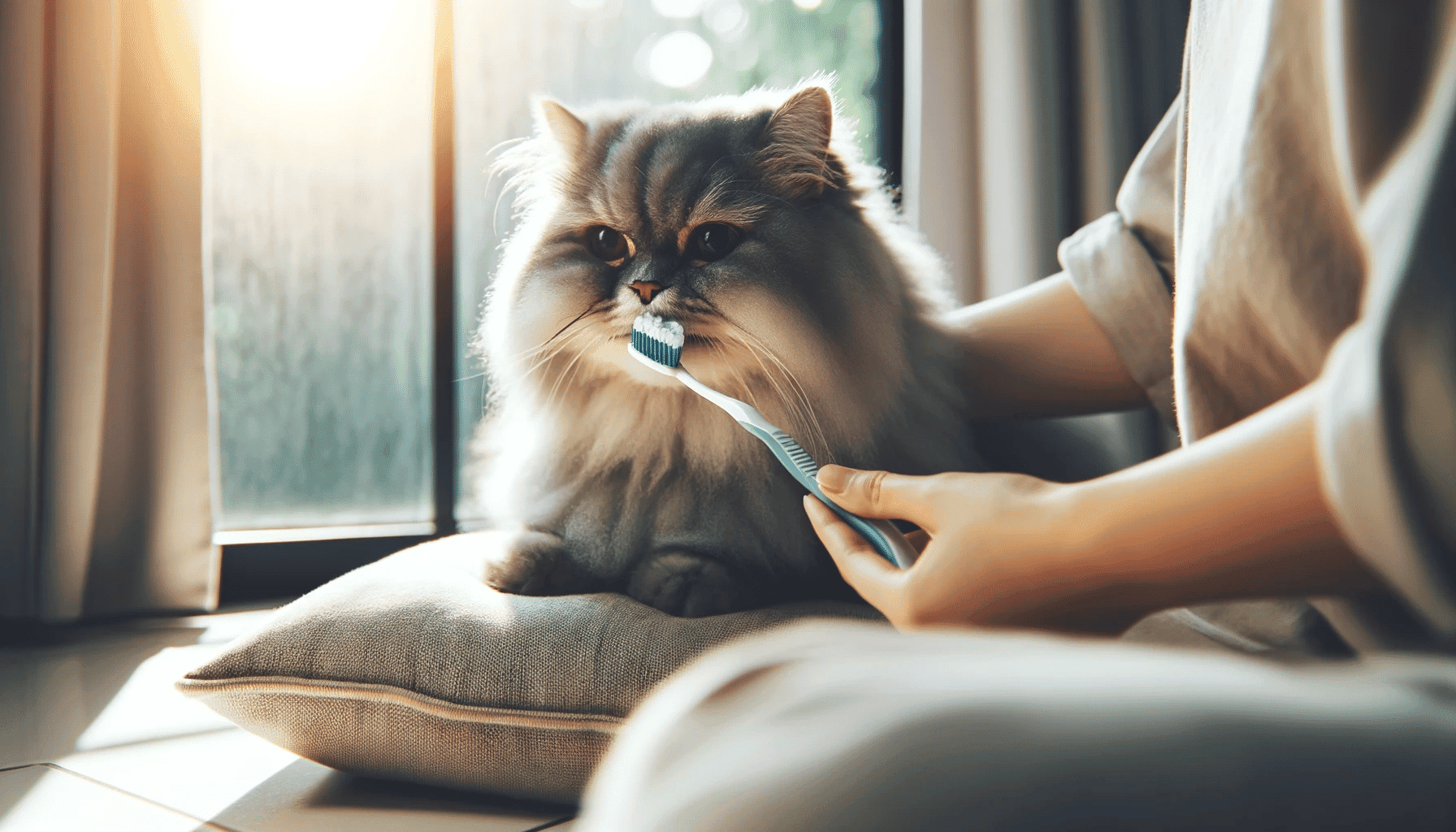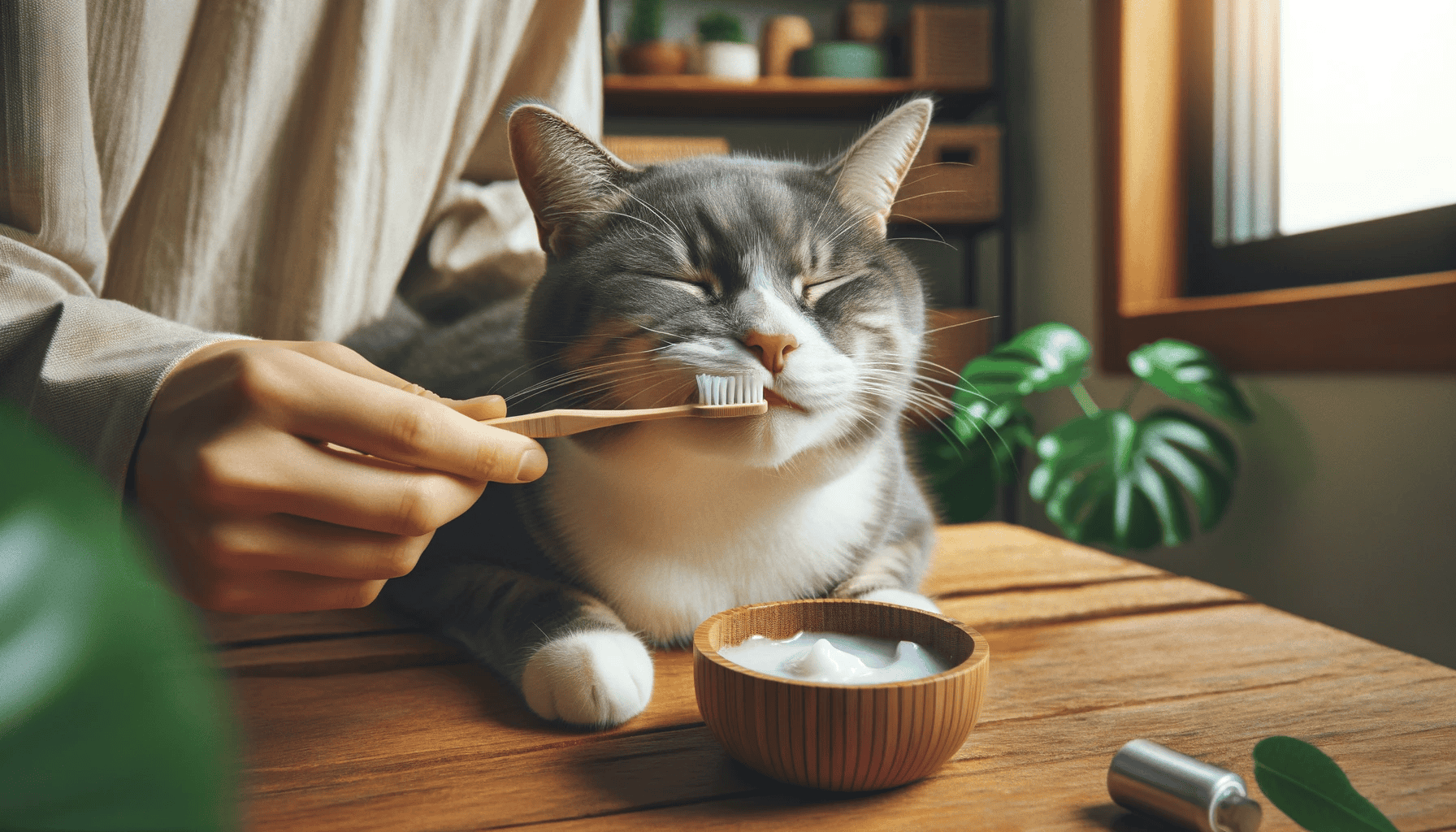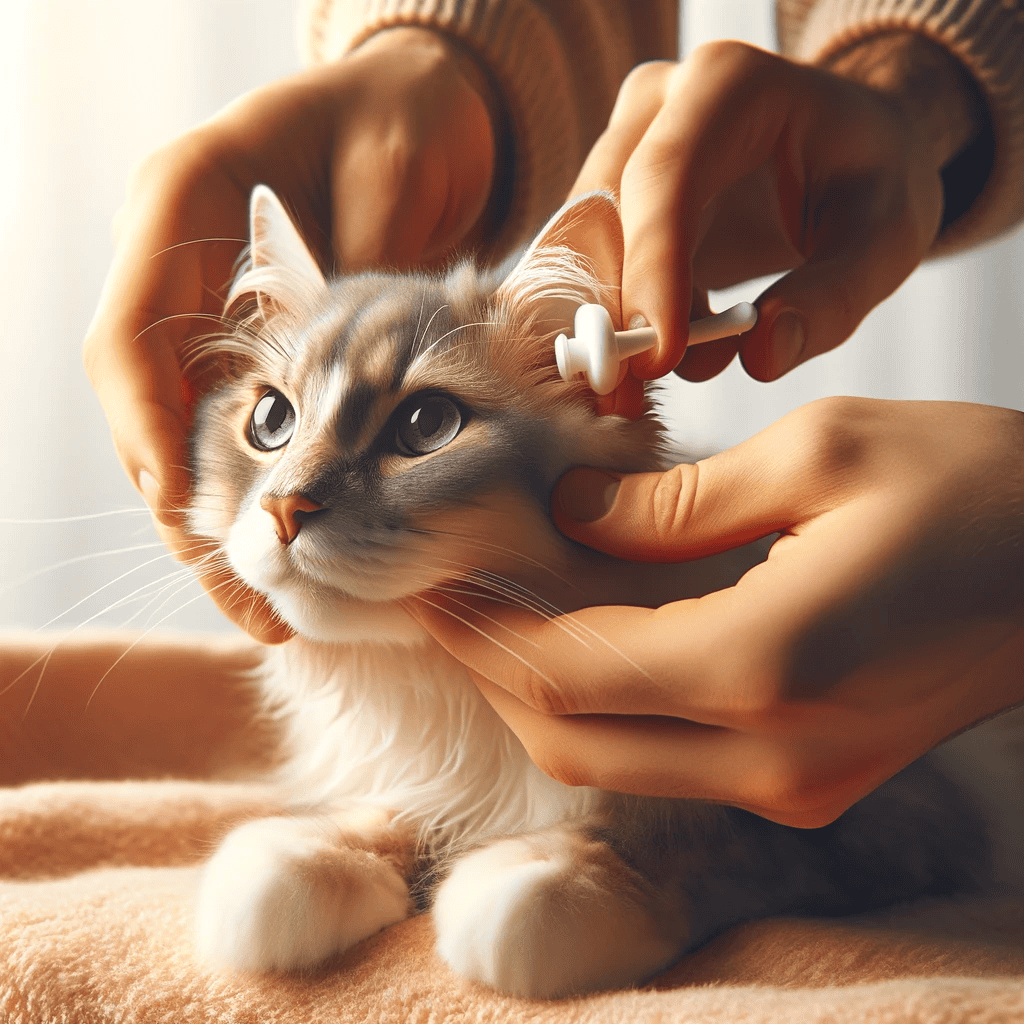
When it comes to cat dental care, brushing your cat’s teeth is crucial for maintaining their oral health. Did you know that over 50% of cats over the age of three develop periodontal disease due to plaque and calculus buildup? Regular brushing can slow down the progression of periodontal disease by removing plaque.
However, you may be wondering if it’s possible to brush your cat’s teeth without toothpaste. The answer is yes! Here’s how you can do it.
Key Takeaways |
|---|
| Brushing your cat’s teeth is important for their feline dental health. |
| Over 50% of cats over the age of three develop periodontal disease. |
| Regular brushing can slow down the progression of periodontal disease. |
| It is possible to brush your cat’s teeth without toothpaste. |
| Using alternative methods and products can still benefit your cat’s oral health. |
The Importance of Brushing Your Cat’s Teeth
Proper dental care is essential for maintaining your cat’s oral health. Just like humans, cats can develop dental issues such as plaque, tartar, and periodontal disease. Regular brushing of your cat’s teeth can help prevent these problems and ensure their overall well-being.
Periodontal disease, if left untreated, can lead to tooth loss and other health complications for your feline friend. By incorporating regular tooth brushing into your cat’s hygiene routine, you can significantly reduce the likelihood of dental issues and their associated consequences.
Regular brushing helps remove plaque and prevents the accumulation of tartar, which can cause bad breath, tooth decay, and gum disease. It also promotes healthy gums and can help detect any abnormalities or changes in your cat’s mouth early on.
The Benefits of Regular Brushing
- Prevents plaque buildup
- Reduces the risk of periodontal disease
- Improves breath odor
- Promotes healthy gums
Establishing a Dental Care Routine
To ensure effective dental care for your cat, it’s important to establish a routine from a young age. Start by introducing your cat to the toothbrush and toothpaste gradually.
Use cat-specific toothbrushes and toothpaste flavors that are appealing to cats, such as poultry or seafood flavors.
When brushing, focus on the outside surfaces of the teeth, especially the back teeth and canines. Be gentle and patient, as some cats may take time to get used to the process. Over time, most cats can accept some level of tooth brushing with a gentle approach.
Professional Dental Care
In addition to regular brushing, it’s important to schedule professional dental cleanings for your cat. Your veterinarian can assess your cat’s dental health and perform a thorough cleaning to remove any tartar and plaque that may have built up.
Regular dental check-ups can help identify any underlying dental issues and ensure timely intervention. Your veterinarian can also offer advice on maintaining your cat’s oral hygiene and address any concerns you may have.
Benefits of Regular Brushing |
Benefits of Professional Dental Care |
|---|---|
| Prevents plaque buildup | Thorough tartar and plaque removal |
| Reduces the risk of periodontal disease | Early detection of dental issues |
| Improves breath odor | Professional assessment of oral health |
| Promotes healthy gums | Expert advice on oral hygiene |
Tips for Brushing Your Cat’s Teeth
When it comes to brushing your cat’s teeth, it’s essential to approach it with the right techniques and tools to ensure a safe and effective brushing experience. Here are some tips to help you brush your cat’s teeth safely and efficiently:
- Choose the right toothbrush: Use a toothbrush specifically designed for cats, with soft bristles that are gentle on their gums. Finger brushes or silicone brushes that slip over your finger can also be useful alternatives.
- Introduce toothpaste gradually: Most cats are sensitive to flavors, so start by letting your cat lick a small amount of pet toothpaste off your finger or the toothbrush. Gradually introduce the toothbrush with a small amount of toothpaste on it, allowing your cat to get used to the sensation.
- Focus on the outside surfaces: Gently lift your cat’s lip to expose their teeth and gums. Use small circular motions to clean the outside surfaces of their teeth, focusing on the back teeth and canines where plaque tends to accumulate the most.
- Be patient and gentle: Brushing your cat’s teeth may take time for them to get used to. Approach it calmly and with patience, rewarding your cat with praise and treats for their cooperation. If your cat becomes stressed or anxious, take a break and try again later.
Additional Tips for a Successful Toothbrushing Session
- Make it a positive experience: Create a calm and comfortable environment for toothbrushing. Choose a quiet area where your cat feels safe, and play soothing music to help them relax.
- Try different flavors: If your cat doesn’t like the first toothpaste flavor you try, experiment with different options until you find one they enjoy. This will make the toothbrushing experience more appealing to them.
- Seek professional help if needed: If you’re struggling to brush your cat’s teeth or notice signs of dental issues, consult a veterinarian. They can provide guidance, perform professional cleanings, and address any underlying dental problems.

With patience, consistency, and the right approach, you can develop a toothbrushing routine that benefits your cat’s oral health. Keep in mind that even if your cat doesn’t fully accept toothbrushing, any effort you make to promote their dental hygiene is valuable.
Toothbrushing Tips for Cats |
Notes |
|---|---|
| Choose the right toothbrush | Use a cat-specific toothbrush or alternative options such as finger brushes or silicone brushes. |
| Introduce toothpaste gradually | Let your cat lick toothpaste off your finger or the toothbrush before introducing brushing. |
| Focus on the outside surfaces | Clean the outer surfaces of teeth, paying attention to back teeth and canines. |
| Be patient and gentle | Approach toothbrushing calmly, rewarding your cat for cooperation, and taking breaks if needed. |
Natural Alternatives to Toothpaste for Brushing Your Cat’s Teeth
If your cat resists toothpaste, there are natural alternatives you can use to maintain their dental health. These alternatives offer effective dental plaque removal in cats without the need for traditional toothpaste.
Coconut Oil
Coconut oil is a safe and natural option for brushing your cat’s teeth. It contains antimicrobial properties that can help combat bacteria in their mouth. To use coconut oil, simply apply a small amount to your cat’s teeth and gums using a toothbrush or your finger. Most cats find the taste of coconut oil pleasant, making it easier to introduce into their oral care routine.
Baking Soda
Baking soda can also be used as a toothpaste alternative for cats. Mix a small amount of baking soda with water to create a paste-like consistency. Gently apply the paste to your cat’s teeth using a toothbrush or your finger. Baking soda helps remove plaque and freshen your cat’s breath. However, it’s important to use baking soda in moderation as it can be abrasive and may cause discomfort if used excessively.
Parsley Water
Parsley water can be used as a natural mouth rinse for your cat. Infuse fresh parsley leaves in warm water and allow it to cool. Once cooled, strain the water and use it as a rinse for your cat’s mouth. Parsley has natural antibacterial properties and can help freshen your cat’s breath while promoting oral health. Simply pour a small amount into your cat’s mouth and allow them to swish it around before spitting it out.
Overall, these natural alternatives offer effective dental plaque removal in cats without the need for traditional toothpaste. Whether your cat resists toothpaste or you prefer natural options, coconut oil, baking soda, and parsley water can help maintain your cat’s oral health. It’s essential to establish a regular dental care routine for your feline friend to prevent dental issues and ensure their overall well-being.
Final Thoughts
Taking care of your cat’s dental health is crucial for their overall well-being. Regular dental care, including brushing your cat’s teeth, is an essential part of their oral hygiene routine. While it may be challenging at first, with patience and persistence, most cats can benefit from tooth brushing.
Using the right tools is key to successful tooth brushing. Cat-specific toothbrushes and toothpaste flavors that cats enjoy can make the process easier. Start slowly and gradually introduce the brush into your cat’s mouth. Focus on cleaning the outside surfaces of the teeth, paying extra attention to the back teeth and canines.
If your cat is resistant to toothpaste, natural alternatives like coconut oil, baking soda, and parsley water can be used. Coconut oil has antimicrobial properties and is enjoyable for most cats. Baking soda, when mixed with water, can create a paste for gentle cleaning. And parsley water can refresh your cat’s breath and promote oral health when used as a mouth rinse.
Remember, in addition to regular tooth brushing, it’s important to schedule professional cleanings and check-ups with your veterinarian. By maintaining a consistent dental care routine, you can help ensure that your cat enjoys good oral health throughout their life.
FAQ
Can I brush my cat’s teeth without toothpaste?
Yes, you can brush your cat’s teeth without toothpaste. There are natural alternatives like coconut oil, baking soda, and parsley water that can be used for tooth brushing.
Why is brushing my cat’s teeth important?
Brushing your cat’s teeth is crucial for maintaining their oral health. Over 50% of cats over the age of three develop periodontal disease due to plaque and calculus buildup. Regular brushing can slow down the progression of periodontal disease by removing plaque.
How can I brush my cat’s teeth?
To brush your cat’s teeth, use cat-specific toothbrushes and toothpaste flavors that are appealing to cats. Start slowly and introduce the brush into their mouth. Focus on cleaning the outside surfaces of the teeth, especially the back teeth and canines.
Are there natural alternatives to toothpaste for brushing my cat’s teeth?
Yes, if your cat resists toothpaste, you can use natural alternatives like coconut oil, baking soda, and parsley water. Coconut oil has antimicrobial properties and a pleasant taste that most cats enjoy. Baking soda can be mixed with water to create a paste, but use it in moderation as it can be abrasive. Parsley water can be used as a mouth rinse to freshen your cat’s breath and promote oral health.
Should I take my cat for professional dental cleanings?
Yes, regular dental care for your cat, including professional cleanings and check-ups, is important for maintaining their oral health.

In her previous life, Lisa traveled extensively, both for work and leisure. After the pandemic struck, Lisa locked up her luggage and adopted a cat ever since.
Lisa is now an avid cat lover, she devotes most of her free time serving as butler to her adorable feline at home. When she is not with her cat, she can be seen using her phone sourcing for the latest cat supplies online.


